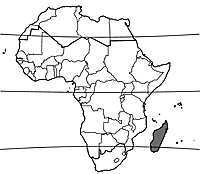Maintenance
All wikis at Biowikifarm are in read-only mode due to the restoration after a severe cyberattack in October 2023.
After 1 year being shut down the Biowikifarm is online again.
You see the latest restored version from 18th October 2023.
Cassia hippophallus (PROTA)
Introduction |
Cassia hippophallus Capuron
- Protologue: Adansonia, sér. 2, 8(1): 22 (1968).
- Family: Caesalpiniaceae (Leguminosae - Caesalpinioideae)
Origin and geographic distribution
Cassia hippophallus is endemic to northern and western Madagascar, from Antsiranana south to the Bemaraha Plateau.
Uses
The wood is used locally for construction.
Properties
It has been reported that leaflets and fruit pulp have laxative properties.
Description
- Deciduous shrub or small tree up to 15(–20) m tall; bole up to 50 cm in diameter; bark surface pale grey, rough, inner bark thick; twigs grey, with lenticels, initially densely yellowish short-hairy.
- Leaves arranged spirally, paripinnately compound with 13–20(–25) pairs of leaflets; stipules minute, caducous; petiole 2–4 cm long, rachis up to 30 cm long; petiolules 2–3 mm long; leaflets usually opposite, oblong to elliptical, slightly asymmetrical, 2–5 cm × 0.5–2 cm, short-hairy on both surfaces.
- Inflorescence an axillary or terminal raceme up to 30 cm long, combined into large panicles, short-hairy; bracts up to 13 mm long.
- Flowers bisexual, nearly regular, 5-merous; pedicel 2.5–4 cm long; sepals free, ovate to elliptical, 7–9 mm long, yellow; petals free, oblong-elliptical, 1.5–2 cm long, bright yellow, the upper petal slightly smaller than the other ones; stamens 10, very unequal, 3 lower ones c. 2.5 cm long, filaments inflated near the middle, 4 central ones up to 1 cm long, and 3 rudimentary up to 6 mm long; ovary superior, narrow and curved, c. 2 cm long, hairy, with stipe c. 5 mm long, style 4–5 mm long.
- Fruit a cylindrical, pendulous pod 8–20 cm × 2.5–3 cm, with a thick stipe, woody, wrinkled, dark brown, with a soft pulp inside, indehiscent, many-seeded.
- Seeds obovoid, compressed, up to 1 cm long, glossy brown.
Other botanical information
The fruits persist for a long time on the ground after they have fallen from the tree.
Until the early 1980s, Cassia was considered a very large genus of about 550 species, but was then split into 3 genera: Cassia s.s. with about 30 species, Chamaecrista and Senna. In Madagascar only 2 Cassia spp. have been found.
Ecology
Cassia hippophallus occurs in deciduous woodland and open scrubland, up to 500(–1150) m altitude. It is often found in margins of woodland, where it is subject to regular fires. It has been recorded on sandy, clayey and limestone soils.
Genetic resources
Considering its preferred habitat, Cassia hippophallus does not seem to be easily threatened by genetic erosion.
Prospects
The wood of Cassia hippophallus is probably only occasionally and locally used, and it is not likely that it will become more important in the future because of the comparatively small size of the bole. In view of the often interesting medicinal properties of other Cassia spp., research on phytochemistry and pharmacological properties may be worthwhile. Cassia hippophallus may have value as ornamental shrub or tree.
Major references
- Capuron, R., 1968. Contributions à l’étude de la flore forestière de Madagascar. A. – Notes sur quelques Cassiées malgaches (1re partie). Adansonia, series 2, 8(1): 17–37.
- du Puy, D.J., Labat, J.N., Rabevohitra, R., Villiers, J.-F., Bosser, J. & Moat, J., 2002. The Leguminosae of Madagascar. Royal Botanic Gardens, Kew, Richmond, United Kingdom. 750 pp.
Other references
- Boiteau, P., Boiteau, M. & Allorge-Boiteau, L., 1999. Dictionnaire des noms malgaches de végétaux. 4 Volumes + Index des noms scientifiques avec leurs équivalents malgaches. Editions Alzieu, Grenoble, France.
- Lewis, G., Schrire, B., MacKinder, B. & Lock, M., 2005. Legumes of the world. Royal Botanic Gardens, Kew, Richmond, United Kingdom. 577 pp.
Author(s)
- R.H.M.J. Lemmens, PROTA Network Office Europe, Wageningen University, P.O. Box 341, 6700 AH Wageningen, Netherlands
Correct citation of this article
Lemmens, R.H.M.J., 2010. Cassia hippophallus Capuron. [Internet] Record from PROTA4U. Lemmens, R.H.M.J., Louppe, D. & Oteng-Amoako, A.A. (Editors). PROTA (Plant Resources of Tropical Africa / Ressources végétales de l’Afrique tropicale), Wageningen, Netherlands.
Accessed 18 December 2024.
- See the Prota4U database.

